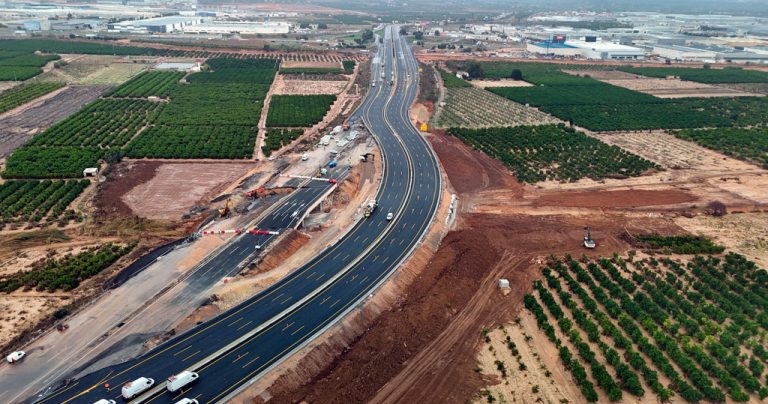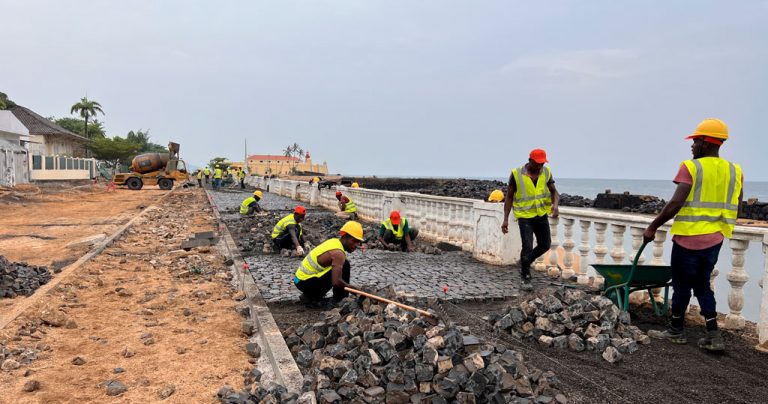What are infrastructure cost estimators
In these lines we will consider an estimator as a mathematical function, graphical or analytical, that allows, with the scarce data that is available before carrying out a design, to make an estimate of the cost of an infrastructure or of its design.
Usefulness of cost estimators
It is an emergency that we recurrently have to address that of an overwhelmed client who needs in one or two days an offer for an urgent job. Evidently, in accordance with our system and with pure rationality, what we should do is refuse … but, fortunately, we do not always act following the easy way. Trust in the client or security in our ability to manage the risks we assume can lead us to offer based on estimators.
Any estimate, however accurate it may be, requires an alternative contrast estimate, which shows whether we are offering competitively or not. And that, by the way, detects if there are singularities in the offer that make it exceptionally expensive or cheap.
My experience has taught me that it is convenient to have quick estimates of the cost of the infrastructures that we project throughout the design process. Budgets are usually the last to close and, on many occasions, they show us figures well above the client’s expectations. What to do then? Well, have early estimates that we will share with the client. Much better not to project elements that will end up being eliminated due to lack of budget. Cheaper, faster, more satisfying.

PMP (Project Management Professional) and cost estimation
To give some context of the state of the art within project management, it should be noted that the PMP itself identifies different types of estimates. Among them:
- Analog estimation, top-down or descending: finding similarities between the case to estimate and previous ones.
- Parametric estimation: applying ratios from other projects. It is somewhat more refined than the previous one and, from a mathematical point of view, it involves establishing a linear relationship between the cost and another parameter, usually dimensional (length, surface, height, volume). This typology, like the previous one, are estimates “top-down”.
- The direct upward estimation, from bottom-up. It is the one we do in all our projects: divide them into activities (packages or work units) that are estimable or measurable. Through basic costs and yields we calculate the costs of these activities, which multiplied by their quantities yield activities cost. Added these, we obtain the cost of the project.
- The three-point estimation, used in the PERT method or critical path. It yields three values: the most likely, the pessimist and the optimist.
Problems of the estimators
Let’s see some difficulties, which generally discourage those who try to approach the calculation of estimators:
- There is no estimator in civil engineering that is both simple and reliable.
- The lack of data before approaching the estimation. This difficulty is becoming increasingly more solvable because, generally, there are previous studies that give us some information.
- The estimators must evolve over time, considering inflation. The costs of past experiences must necessarily be updated.
- Almost all experiences have had singularities that must be disaggregated or addressed in a specific way. Unexpectedly difficult geology, a distrustful or demanding client that has forced repetitions or design modifications, or a poor starting solution are very common causes of increased costs or delays in our work. Other times, cost distortions stem from country difficulties (including obtaining visas), culture, religion, lack of funds, social or environmental problems, etc.
- The economic context of the country where the project will be carried out is also decisive and can adjust the offer either upwards or downwards.
Overcoming difficulties: suggested techniques
Certainly, each of us may have different approaches to address the aforementioned difficulties.
In my case, the approach used has been to outsource non-standard elements of the project through multiplier coefficients. The user has to input a minimum value, an expected value, and a maximum value for each multiplier. Some of the applied multipliers (not necessarily in all estimators) are as follows:
- Cumulative inflation since the year of the last estimator update.
- Commercial aggressiveness of the country.
- Urban environment (increases costs) or open field.
- Straight or curved layout (great impact on conduits).
- Entity of the project: larger projects allow for the use of more powerful means, resulting in higher efficiency.
- Difficulties of the country or the client.
These multipliers will affect the calculation of the “theoretical” cost of the infrastructure, creating a range of values associated with different levels of estimation certainty. This dispersion should not discourage us. On the contrary, it reflects the reality of the impossibility of knowing the exact costs of an infrastructure, not only before constructing it but even before designing it.
To approach the theoretical cost of the infrastructure, various approaches are possible. All of them are valid, and in each case, the most favourable one should be used. Obviously, the levels of precision obtained will be different.
Statistical approach
The first approach is purely statistical. That’s what CEDEX did in 2010 with its Technical Guide for the Characterization of Structural Measures. With the support of different confederations, they collected the cost and representative characteristics of a large number of different infrastructures, such as dams, storm tanks, conduits, etc.
At that point, we need to decide, with some insight, which variable or variables the cost is correlated with. In the case of dams, it was the height, and in the case of tanks, it was the volume. From there, they are graphically represented (height/cost, volume/cost), a function is fitted, and the coefficient of correlation R2 is calculated. If it turns out to be satisfactory, we have completed the process.
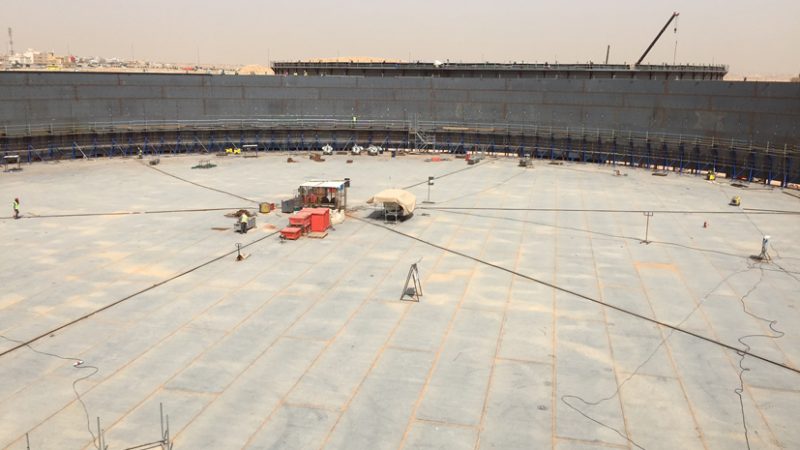
The examples above show the inherent limitations of the process. Does the transport distance of materials or the difficulty of diverting the river not really influence the cost of the dam?
The adjustment doesn’t necessarily have to be to a single variable. In fact, by adding a little more complexity, we can find much better-fitted results.
Analysing, for example, a road, its cost C (whether for construction or design) will vary linearly with the length of the conventional route LC, the length of tunnels LT, and the length of bridges LB. That is:
C = K1 LC + K2 LT + K3 LB
Now the problem is reduced to obtaining the coefficients Ki. This is where statistics come in: we need to know the cost of at least three projects, setting up a system of three equations with three unknowns. If we have more cases, even better: we can refine the solution using the method of least squares or any other method. Additionally, we will obtain ranges of variation for the coefficients Ki, allowing us to obtain a range of results.
Having a good database is essential for knowing the costs of other projects.
The method can be further improved by adjusting different Ki coefficients based on the characteristics of the terrain or infrastructure.
The effectiveness of the method will depend on the suitability of the equation describing the cost and the amount of data available for adjustment.
As an example of this method, we have just developed a cost estimator for buried retention tanks. Rationalising the equation approach involves assuming that the cost is the sum of the following elements:
- Perimeter walls or screens, which depend on the product of the perimeter P multiplied by the square of the height H2.
- Excavation, which depends on the volume V of the tank.
- Roof and foundation slab, which depend on the surface area S of the tank.
- Columns, which depend on the surface area and height of the tank, which is equivalent to the volume.
That is:
C = K1 PH2+ K2 V + K3 S
In the common case of rectangular-base tanks, it can be shown that the above equation is equivalent to the following one:
C = K4 V0,5 H1,5+ K5 V + K6 V/H
The above expression is relevant because it refutes the common belief that the cost can be adjusted by only knowing the volume. In our case, it has allowed us to optimise the design by obtaining the optimal height for each volume, understood as the height that minimises the cost. As expected, the optimal height increases with the volume. The estimator has allowed us to compare solutions composed of a large number of tanks and has been applied in our stormwater flood projects. In the figure, we can visualise the results obtained.
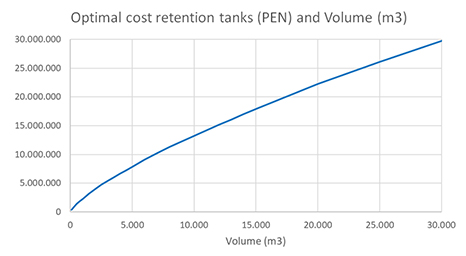
Hybrid method
In this method, we divide the problem into the sum of two components.
The first component consists of a direct calculation of the cost of a part of the infrastructure, which can be addressed with a few data points. For example, the cost of a dam body depends primarily on its volume, which can be obtained, although approximately, with a few data points from the terrain (channel width, crest width, height), easily accessible, and the geometric definition of the dam body.
Another example is the cost of sewers or pipelines in general: it can be calculated as long as the characteristics of the conduit (material, diameter, maximum working pressure) are known and average installation conditions are assumed, such as excavation slopes and backfill height over the conduit. This way, we can determine the deterministic component of the cost with great precision.
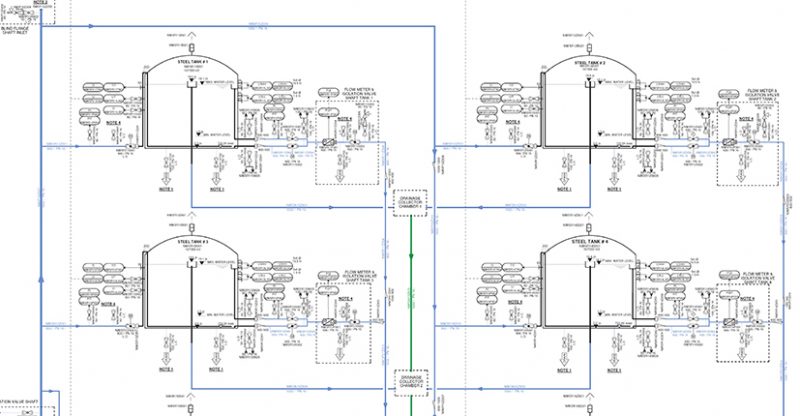
The second component is statistical. In the case of the dam, it includes the cost of the hydraulic elements of the project: spillways, bottom outlets and river diversion works. This is where we have to resort to the analysis of databases of known projects. In our case, we have approached this by differentiating between dam typologies – hydraulic elements are much more expensive in earth dams – and ranges of ratios based on the difficulty of the element. Naturally, the analysis and adjustment work is important and requires experience, engineering judgment, and time.
In the case of pipelines, the statistical component includes the cost of concrete thrust blocks, manholes, valves, and unique elements.
Proposals and conclusions
As a result of the work carried out at TYPSA, we now have validated estimators for dams, hydroelectric power plants, reservoirs, pressurised pipelines and sewers, pumping stations, and retention tanks. Some attempts have also been made for roads, and there are plans to develop estimators for bridges and flood studies. In some cases we study the construction and in some others, the design. All of these estimators are available to those who need them.
While the different divisions are responsible for managing the knowledge of our projects, I believe we should double efforts in systematising the calculation of estimators. Not only are there many missing estimators, but also the existing ones can be improved and better calibrated.
The ideal place to carry out this systematisation could be the feedback report of projects, which I consider essential for projects of a certain magnitude.
We all know the importance of having data and knowing how to process and manage them. We have the data: it’s in Concost. We also have the knowledge and human talent to process it. We just need the conviction of the importance of investing a little time in extracting the lessons learned in terms of estimators. The results could be stored, managed, and transmitted by the divisions, serving for the estimation of future projects and bids. In the opinion of the author of these lines, this would be valuable information that would require the utmost confidentiality.
The objective, a mix of utopia and ambition, is to ensure that each project starts where the previous one ended, rather than starting from scratch. Let’s not reinvent the wheel every day!




